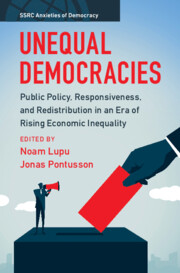Tables
1.1Inequality and redistribution among working-age households, 1995–2007
1.2Top-10-percent income shares and redistribution, 1995–2007
1.3Inequality and redistribution among working-age households, 2007–2018
1.4Top-10-percent income shares and redistribution, 2007–2019
2.2Average values of independent and dependent variables by country
2.3Average marginal effects of support for policy change when preferences diverge by at least 10 percentage points (two-year windows)
2.4Average marginal effects of preference gaps on policy adoption, controlling for P50 support (two-year windows)
2.5Linear probability models interacting the P90–P10 preference gap with Left government (two-year windows)
2.6Linear probability models interacting the P90–P50 preference gap with Left government (two-year windows)
2.7Average marginal effects of preference gaps on policy adoption, controlling for P50 support, economic, and welfare issues only (two-year windows)
3.1Determinants of net transfers to M as a percentage of H’s net income
3.2Determinants of net transfers to L and H as a percentage of own net income
6.2Group strength, electoral selection, lobbying, and legislative responsiveness
6.4Estimates of group strength on roll-call votes for some key bills with high support among low-income constituents
7.1Discontinuities in political and socioeconomic covariates
7.2Effect of mayors with university degrees on performance outcomes
7.3Effect of mayors with university degrees on fiscal outcomes
7.4Effect of mayors with university degrees on key revenue categories and tax rates
7.6Effect of mayors with university degrees on lagged fiscal outcomes
7.7Heterogeneous effects of governments’ education: left- and right-wing parties
9.1Oaxaca–Blinder decomposition of the voting gap between high income/highly educated and low income/low educated
10.1Attitude structure in Great Britain: confirmatory factor analysis
10.3Opposition to redistribution is not predicted by reciprocity beliefs
10.4Proportionality beliefs and “redistribution from”: factor loadings
13.1Strength of expected class bias in representation of social policy preferences, depending on challenger parties

